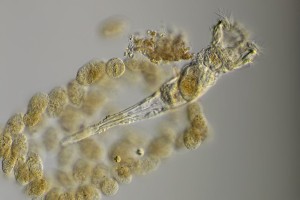
As a child, I was given a small microscope. It wasn’t very powerful, but some small life forms could be seen using it. I visited the fish pond in our back yard and scraped some mossy scum along its bottom. What I saw under the glass surprised me.
It looked like an upright vacuum cleaner. It was a rotifer. Ever heard of a rotifer?
Rotifers may be seen in this enchanting video…
A Brief Description
The rotifer has been described as “an animal like a large maggot which could contract itself into a spherical figure and then stretch itself out again; the end of its tail appeared with a forceps like that of an earwig”.¹
This may best describe the bdellid rotifer. Its crown features a cilia covered, two wheel structure. That structure produces a vacuum that draws in smaller creatures as food. It should be noted that, although the wheels seem to rotate, they actually do not do so. Rather, the cilia engage in a sequential flapping motion that makes the wheels appear to rotate.
Why the Rotifer is Special
The rotifer eats algae, bacteria, and protozoa. This helps produce pure, clear water. In addition, the creature serves as food for certain fish. Finally, the existence of the rotifer helps us appreciate that life is not here by accident. Each creature serves a useful purpose.
The Rotifer and the Sewer Plant
I once operated a sewer plant. I would frequently examine samples of in process waste water to see if all the processes were functioning properly. The presence of a large number of rotifers was not considered desirable. Why was that the case?
There are many other forms of life found sewer sludge besides rotifers. An abundance of stalked ciliates is considered very desirable—indicative of stability. It is good to see some free-swimming ciliates, a few flagellates, and a just few rotifers.
An abundance of rotifers in the effluent indicates there is entirely too high a level of solids. This means too much too many “nutrients”are being released back into the ecosystem, perhaps a stream. In this case, a lack of rotifers is a good thing. The water being returned to the environment is clean, clear, and probably drinkable.
1 John Harris, 1696.
Note: You might also enjoy Volvox Reproduction and Morphogenesis
References:
- Mountain Empire Community College: Environmental Microbiology: Metazoa
- EPA: Wastewater Treatment Manuals: Primary, Secondary, and Tertiary Treatment
← Back to Classic Science
← Home
